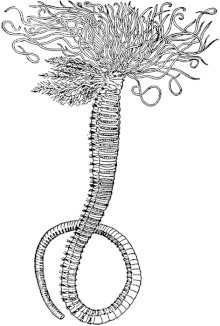| Amphitrite ornata | |
|---|---|
 | |
| Scientific classification | |
| Domain: | Eukaryota |
| Kingdom: | Animalia |
| Phylum: | Annelida |
| Clade: | Pleistoannelida |
| Subclass: | Sedentaria |
| Order: | Terebellida |
| Family: | Terebellidae |
| Genus: | Amphitrite |
| Species: | A. ornata |
| Binomial name | |
| Amphitrite ornata | |
| Synonyms | |
| |
Amphitrite ornata or ornate worm, is a species of marine polychaete worm in the family Terebellidae.[1]
Polychaetes, or marine bristle worms, have elongated bodies divided into many segments. Each segment may bear setae (bristles) and parapodia (paddle-like appendages). Some species live freely, either swimming, crawling or burrowing, and these are known as "errant". Others live permanently in tubes, either calcareous or parchment-like, and these are known as "sedentary".
Distribution
This species is found in Cobscook Bay, the Gulf of Maine and the north west Atlantic Ocean at a depth of up to 200 metres.[2]
Description
The ornate worm can grow to up to forty centimetres long and lives in a firm, sand-encrusted tube. All that is visible are the three bright red bushy gills and a spread of long, peach-coloured tentacles above them. The tentacles can extend to forty centimetres and are constantly in motion, searching for food particles.[3] The rest of the worm's segmented, tapering body remains concealed in the tube.[4]
Biology
This worm lives in a tough U-shaped tube in the mud substrate. The sexes are separate and the females can be distinguished by their darker abdominal segments. Spawning takes place in June to August, peaking in July, especially around the periods of new and full moon and the subsequent increase in tidal flows. The eggs and sperm develop and float freely in the body cavity of the worm but by some little understood process, only the ripe products are released.[5] The eggs are fertilized externally and the rate of development of the larvae is rapid. Swimming forms are present four to five hours after fertilization, and well-formed trochophores within 20 hours. Larval segmentation begins at 36 hours and metamorphosis starts at about the fifth day, when five trunk segments are already present. At this stage, the larvae cease to swim about freely and sink to the sea floor. Metamorphosis is complete by the eleventh day.[6][7]
Ecology
This worm is often found associated with the fringe worm, Cirratulus cirriformia, in the littoral and sublittoral zones, in soft mud and under stones.[3] The tiny pea crab Pinnixa chaetopterana is sometimes found living as a commensal inside the tube behind the worm.[8]
The ornate worm is often found in marine environments also inhabited by Notomastus lobatus (Polychaeta) and Saccoglossus kowalewskyi (Hemichordata), which produce and contaminate sediments with bromophenols and bromopyrroles.[9] These organic halogen metabolites are toxic and it has been found that A. ornata produces a novel dehaloperoxidase that detoxifies haloaromatic compounds. The genes responsible have been identified.[10]
References
- 1 2 Read G, Fauchald K, eds. (2021). "Amphitrite ornata (Leidy, 1855)". World Polychaeta database. World Register of Marine Species. Retrieved 9 December 2021.
- ↑ Encyclopedia of Life
- 1 2 Life in Chesapeake Bay
- ↑ Image of Amphitrite ornata
- ↑ Scott, John W. (1909). "Some egg-laying habits of Amphitrite ornata Verrill". Biological Bulletin. 17 (5): 327–340. doi:10.2307/1536055. JSTOR 1536055.
- ↑ Mead, A. D. (1897). "The early development of marine annelids". Journal of Morphology. 13 (2): 227–326. doi:10.1002/jmor.1050130202. hdl:2027/hvd.32044107331720. S2CID 85381600.
- ↑ Amphitrite ornata Archived September 27, 2011, at the Wayback Machine
- ↑ Walter J. Craig, Jr. (1974). "Physiological ecology of the commensal crabs, Polyonyx gibbesi Haig and Pinnixa chaetopterana Stimpson". Oecologia. 15 (3): 235–244. doi:10.1007/bf00345180. JSTOR 4214961. PMID 28308549. S2CID 117693.
- ↑ Chen, Yung Pin; Woodin, Sarah A.; Lincoln, David E.; Lovell, Charles R. (1996). "An unusual dehalogenating peroxidase from the marine terebellid polychaete Amphitrite ornata". Journal of Biological Chemistry. 271 (9): 4609–4612. doi:10.1074/jbc.271.9.4609. PMID 8617721.
- ↑ Han, Kaiping; Woodin, Sarah A.; Lincoln, David E.; Fielman, Kevin T.; Ely, Bert (2001). "Amphitrite ornata, a marine worm, contains two dehaloperoxidase genes". Marine Biotechnology. 3 (3): 287–292. doi:10.1007/s10126-001-0003-8. PMID 14961367. S2CID 2530339.